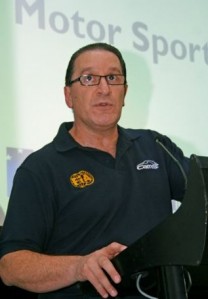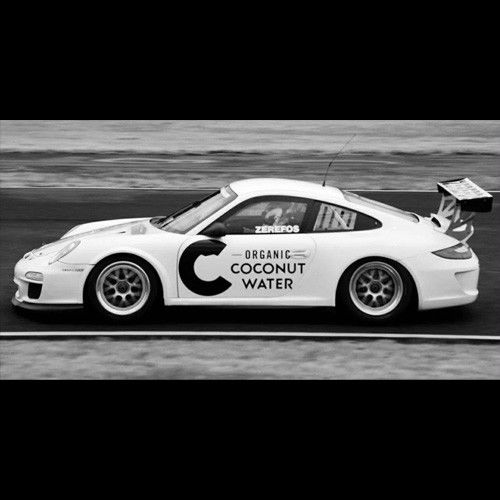

The Confederation of Australian Motorsport has made bold and crucial decisions in reshaping the development path for the nation’s open-wheel talent.
Following the announcement that an Australian FIA Formula 4 Championship will take place in 2015, Speedcafe.com’s Stefan Bartholomaeus spoke to CAMS chief executive Eugene Arocca about the road ahead.
SPEEDCAFE: Eugene, a big announcement for the future of open-wheel racing in Australia with the confirmation of Formula 4. Why is this the right way to go for Australia?
EUGENE AROCCA: We announced a few weeks back that we wanted to develop a real pathway for emerging talent.
We took the view that Formula Ford, while it had a fantastic record in the past, was not meeting our expectations for top level and world standard drivers on the open-wheel pathway. As part of that review we put an end to the Formula Ford Championship and now we’ve re-introduced it as a series.
With what’s been happening overseas and talking to the FIA, the decision was almost inevitable as Formula 4 is seen as the best step out of karting into the open-wheel pathway, before ultimately going on to F3 either here or overseas.
We felt the single engine, single chassis model was something that is appealing with 160bhp. For our board and our executives, it was the obvious pathway to follow.
SPEEDCAFE: You mention Formula 3 as an option either here or overseas. So Australian Formula 3 is an important part of this pathway?
AROCCA: At the moment we need to support Formula 3 (in Australia). Numbers have been down a bit and we think that a strong and vibrant Formula 3 can only be achieved with a strong and vibrant Formula 4.
It’s like the AFL needing a good junior competition, such as the TAC Cup. It (F3) needs to be supported from below. We see that by introducing a Formula 4 competition in 2015 and dedicating time and resources to Formula 3 in 2014 we can create very clear and transparent pathway through karting, Formula 4 and Formula 3.
If Formula 3 here is vibrant it’s a clear place that kids can go, and if Formula 3 overseas is equally strong that’s another alternative, but in Australia we’d like to provide a three-tier structure for progression.
SPEEDCAFE: Those who have been watching Australian wings-and-slicks racing over recent decades may find it hard to image that two classes can be sustainable. What can be done directly to help F3?
AROCCA: At the same time that we’ve been looking at the pathway we’ve been taking greater accountability for driver development in Australia. We believe there’s a need for that to be ramped up, which is why we have appointed a driver development manager (Cameron McConville).
With that we’re working on a plan for drivers to move through Formula 4 and Formula 3 with support from CAMS. I can’t tell you what shape that will take yet, we’ve obviously got to tender it in the market over the next few months, but we believe that CAMS has a responsibility to ensure that the pathway is clear and is supported.
That means Formula 3 also should be supported. At the moment we award our Gold Star to the best driver in Formula 3 and we want to continue that. We also want to make sure that the opportunities for young and talented drivers to transition from Formula 4 to Formula 3 are made easier. That can be achieved if Formula 3 has strong grid numbers and is well supported by the rest of the market.
SPEEDCAFE: Ultimately market forces will dictate what survives…
AROCCA: Yes, but for us at CAMS, it was too big a leap from karting to Formula 3 in wings-and-slicks, which is why we wanted to introduce a category in between those two.
But Formula 3 is very much a part of our plan, so we expect and hope that it will flourish alongside a strong Formula 4. If I was trying to develop a young driver I’d buy a Formula 4 and a Formula 3. People should not see this as anything other than a move to provide a good, strong stepping stone for karters into Formula 3, either here or overseas.
SPEEDCAFE: You mention that tender processes are yet to get underway. Does that process include decisions on engine and chassis manufacturers?
AROCCA: We’re already talking to engine and chassis manufacturers. That’s the easy part of the equation; we don’t see that as being too difficult and those talks are well advanced.
What we’re focussing on is finding someone to run the actual category. CAMS doesn’t see its role as actually running a Formula 4 category itself.
We’ll look at a variety of different options that will come out in the tender process. We’ve given ourselves plenty of lead time, but we thought we needed to make the announcement in the marketplace now because there are a lot of people asking about what’s happening.
We thought we owed it to the motorsport community to say, ‘here’s our plan and we’re open for tenders to run the championship’. We’ll settle on the engine and the chassis and then allow people to come to us about how they see the category running.
The three key components for us are; driver development, quality of talent – therefore a highly controlled category – and thirdly a cost element that makes it affordable. They are the three keys that will be outstandingly obvious in our tender.
Right now we’re in the process of drafting that and engaging the stakeholders to see what form that tender should take. I should imagine that in the next four to eight weeks something will be issued that people will be able to get their heads around.
SPEEDCAFE: Has it been decided whether the category should run in a traditional teams format or under one roof, like we’ve seen with Jonathon Palmer’s Palmer Audi and Formula 2 classes in the past?
AROCCA: That is part of the process we’re currently undertaking. We need to see what the interest in the market is. We have our own view of what it could look like, but we can’t impose that on others until we find out what they’re intending themselves.
There are some philosophical debates that could flow from a single entity controlling 24 cars, and there are other philosophical arguments about teams running cars, and indeed mums and dads. We want to analyse information we’re getting from overseas, and also what we’re hearing from the marketplace here in Australia, and we’ll make that decision when we feel most comfortable.
Right now there are three key elements that have to be met; and if someone can convince us that they can meet those then that’ll be the pathway we’ll take in terms of how it should run.
We will be very insistent on those three elements being maintained and it may very well be that part of the category manager that steps up to the plate will be a commitment by them to driver development in some form. I don’t know what that will be and it’s not for me to discuss at this point.
SPEEDCAFE: On the engine side, the backing of a car manufacturer appears vital for this work. To make this announcement you must be confident that there’s someone out there who wants to make it happen?
AROCCA: Around the world at the moment there is a lot of activity dealing with both the preferred chassis and the preferred engine. We will make a decision based on what is deemed to be the best for Australian motorsport.
There is a bit of interest out there and we’re confident that we’ll secure an engine and a chassis manufacturer that will then be to the benefit and advantage of any category manager. We will have already done the legwork beforehand.
More announcements will hopefully flow in the near future about that, but right now we’re very confident that the pathway set out by the FIA and endorsed by the Single Seater Commission is something we need to embrace and attack with vigour in order to make sure our drivers aren’t left behind on the grid.
We have the view that success at the international level can only be good for motorsport in Australia generally, from the top right down to grass roots. It’s fantastic to have a vibrant national V8 competition and it’s fantastic that they’ve been looking at overseas markets, but for top-end driver development for the elite levels of Formula 1, rally or IndyCar… the benefits of success at those levels will flow down through the community here.
SPEEDCAFE: Gerhard Berger commended CAMS in your statement for leading the way by introducing Formula 4. Is it a risk that the formula is not yet proven elsewhere? Or do you see it working here independently of what happens overseas?
AROCCA: Well Gerhard is very excited about what we’re doing leading the way in the Asia Pacific region, but we’re certainly not the first to commit to it in the world. There are two, possibly three, European countries, such as the MSA in the UK, that have declared a 2015 championship.
Gerhard is speaking to a variety of ASNs and for CAMS to come out this strongly and make this statement is obviously something that he’s endorsing. We’re talking to other ASNs as well and seeing what’s happening overseas. We’re also talking to manufacturers both here and overseas.
SPEEDCAFE: You mention the Asia Pacific region there. Is the CAMS Formula 4 Championship something that is going to be purely domestic? Or is there a possibility that it could become a regional championship?
AROCCA: We think that Australia, like in everything, would be foolish not to recognise that we are part of a flourishing Asia Pacific region. We recently held the FIA regional academy for Asia Pacific. We see that there are opportunities for overseas competitors to come and compete here down the track with a strong and vibrant Formula 4 or Formula 3.
We are committed to ensuring that Australian motorsport thrives on this opportunity, which inevitably means engaging with the Asia Pacific region. It may be that we will have overseas drivers on the grid in Formula 4 and Formula 3, but the main priority is to capture what’s already here, develop it and promote it.
SPEEDCAFE: Like most new classes, Formula 4 is being touted as low-cost. What are the numbers that are being projected?
AROCCA: The FIA has made it very clear that they are looking at complete cars for 30,000 to 45,000 Euro ($42,000 to $62,000 AUD). We’ve already spoken to some manufacturers that are quite comfortable with those cost expectations.
We remain optimistic that cost… a lot of naysayers are saying that cost will blow out again, but I think that when you’ve got the full force of the FIA behind you, anyone who wants to put their hand up and run the category will have to make sure that they meet those expectations on costs.
SPEEDCAFE: Where the championship runs is clearly important, whether it be with the V8 Supercars, Shannons Nationals or wherever. Are you at the point of discussing that?
AROCCA: We have started looking at that detail and it’s fair to say that all doors are open to us. A number of levels are kicking doors open to take us on, which gives us even greater confidence. We haven’t concluded those discussions but we’ve certainly started talking.
This will be a high-level, high exposure category with real sizzle, leading into what we will believe will be a strong Formula 3. It may take some time but we’re very confident that people will look back at 2013 as a watershed year in Australian motorsport.




















